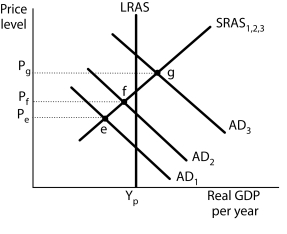A) a one-time increase in money growth.
B) a continuous increase in the money growth rate.
C) a continuous increase in aggregate demand.
D) the rising price of oil.
Correct Answer

verified
Correct Answer
verified
Multiple Choice
Which of the following affect the values of inflation and unemployment? I.changes in government spending II.expectations about the price level III.changes in nominal wages IV.changes in money supply
A) I and IV only
B) I, II, and IV only
C) II and III only
D) I, II, III, and IV
Correct Answer

verified
Correct Answer
verified
Multiple Choice
Suppose that rising productivity increases potential output in each period by 4%.What kind of monetary policy would be needed to maintain a zero rate of inflation at full employment?
A) It should keep money supply constant.
B) It should increase money supply by 4% per period.
C) It should increase money supply by 4% in the first period and thereafter, hold money supply constant.
D) It should decrease money supply by 4% each period.
Correct Answer

verified
Correct Answer
verified
Multiple Choice
Prior to the 1970s, the model of choice was the aggregate expenditures model.According to This model, if the economy was in equilibrium below full employment, then the primary economic problem would be
A) unemployment.
B) deflation.
C) financing the government budget deficit.
D) financing unemployment compensation.
Correct Answer

verified
Correct Answer
verified
True/False
Sustained inflation over many years is most likely due to increases in the money supply in excess of increases in potential output.
Correct Answer

verified
Correct Answer
verified
Multiple Choice
In the recovery phase of the inflation-unemployment cycle,
A) inflation and unemployment fall.
B) inflation rises as unemployment falls.
C) inflation falls as unemployment rises.
D) inflation and real GDP rise.
Correct Answer

verified
Correct Answer
verified
Multiple Choice
In the recovery phase of the inflation-unemployment cycle,
A) the inflation rate rises.
B) although the price level rises, the inflation rate falls.
C) the price level falls.
D) the price level and the inflation rate fall.
Correct Answer

verified
Correct Answer
verified
Multiple Choice
Figure 16-6
 -Refer to Figure 16-6.Suppose the economy was operating at point e in period 1.Expansionary fiscal and monetary policies adopted in period 1 resulted in a movement to point g in period 3.What happens when workers and firms become aware of a rise in the general price to Pg?
-Refer to Figure 16-6.Suppose the economy was operating at point e in period 1.Expansionary fiscal and monetary policies adopted in period 1 resulted in a movement to point g in period 3.What happens when workers and firms become aware of a rise in the general price to Pg?
A) Workers will agree to take wage cuts and firms will agree to lower prices to ward off inflation.
B) They will revise their expectations of future prices to incorporate the higher price level.
C) Firms with sticky prices will ultimately adjust their prices downward.
D) Firms and workers will agree to renegotiate wage contracts downward.
Correct Answer

verified
Correct Answer
verified
Multiple Choice
Which of the following is a cost of unemployment? I.output foregone II.unemployment compensation that must be paid III.rising inflation that erodes the value of money
A) I, II, and III
B) I and II
C) I and III
D) II and III
Correct Answer

verified
Correct Answer
verified
Multiple Choice
As the duration of job search increases, there will likely be
A) an increase in the reservation wage and an increase in the best offer received.
B) an increase in the reservation wage and a decrease in the best offer received.
C) a decrease in the reservation wage and an increase in the best offer received.
D) a decrease in the reservation wage and a decrease in the best offer received.
Correct Answer

verified
Correct Answer
verified
Multiple Choice
Suppose an economy is operating with a contractionary gap.In this case, policymakers would seek to move the economy
A) back down the Phillips curve toward an unemployment rate that is closer to the natural rate of unemployment.
B) up the Phillips curve toward an unemployment rate that is closer to the natural rate of unemployment.
C) back down the Phillips curve toward an unemployment rate that is further from the natural rate of unemployment.
D) up the Phillips curve toward an unemployment rate that is further from the natural rate of unemployment.
Correct Answer

verified
Correct Answer
verified
Multiple Choice
Figure 16-7
 -Refer to Figure 16-7.If the economy is in equilibrium at point 3,
-Refer to Figure 16-7.If the economy is in equilibrium at point 3,
A) it will most likely stay there for an indeterminate period.
B) the SRAS will most likely shift to the left because of firms and workers asking for higher prices and wages.
C) it will move to point 5 because of a shift in the aggregate supply curve from SRAS1 to SRAS2.
D) it will move to point 2 because the aggregate demand curve is likely to shift left in response to higher prices.
Correct Answer

verified
Correct Answer
verified
Multiple Choice
In the three phases of the inflation-unemployment cycle, a period marked by rising unemployment and high inflation is called the
A) inflationary phase.
B) stagflation phase.
C) Phillips phase.
D) recovery phase.
Correct Answer

verified
Correct Answer
verified
Multiple Choice
The efficiency-wage theory predicts that
A) profit-maximizing firms will maintain the wage level at a rate too low to achieve full employment in the labor market.
B) wage rigidities will be eliminated even in the short-run.
C) will maintain the wage level at a rate too high to achieve full employment in the labor market.
D) the labor market clears at a wage rate above equilibrium.
Correct Answer

verified
Correct Answer
verified
True/False
For a given labor force, an increase in real GDP implies a decrease in unemployment.
Correct Answer

verified
Correct Answer
verified
Showing 121 - 135 of 135
Related Exams